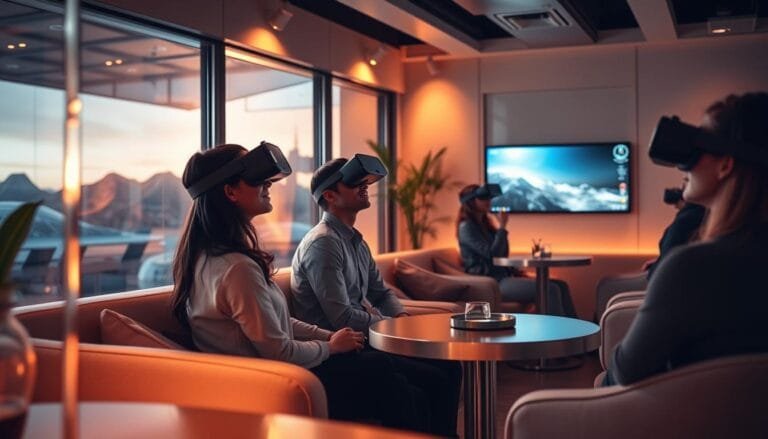Step into a world where the line between screen and self blurs. This roundup invites you to feel each glance, heartbeat, and choice as part of a lived experience. Expect pulse-quickening action, tight pacing, and adventurous set pieces that keep you on edge.
We guide you through standout titles, platforms, and co-op modes so you can match visuals, comfort, and Virtual Reality Zombie Game. Learn how head-tracked awareness and physical weapon handling change familiar genres into fully immersive adventures.
Along the way, find practical tips on session length, difficulty, and comfort. Whether you prefer narrative survival or kinetic shooters, this section shows how each game shapes tension and agency to keep you engaged.
Key Takeaways
- Immersion matters: head tracking and haptics heighten every moment.
- Choose your setup: headset comfort affects session length and performance.
- Play style options: narrative, co-op, and free-roam modes fit different tastes.
- Practical tips: balance difficulty and breaks for longer, safer sessions.
- Replay value: emergent systems and set pieces keep the experience fresh.
Why zombie VR games are the ultimate survival-thriller experience right now
When your head is the camera, suspense stops being something you watch and becomes something you do. That shift is the core of why these titles hit harder today.
The immersion leap: head-tracked awareness replaces passive camera cuts. Looking the wrong way can get you cornered, so instincts and quick glances matter more than ever.
The immersion leap: from 2D screens to head-tracked panic
Modern headsets like PSVR 2, Meta Quest 3, and HTC Vive supply the tracking, fidelity, and haptics that turn simple scenarios into urgent threats.
Spatial audio and full 360° vision push basics—positioning, resource management, and situational awareness—to the front of every session.
Inspiration to act: step into the apocalypse with purpose
Horror here feels visceral yet empowering; actions such as ducking, peeking, and physically reloading convert fear into focused motion.
Survival becomes a mindset. You plan routes, ration ammo, and improvise barricades, and the medium’s immediacy teaches you fast—hesitation costs lives.
- Presence over presentation: every sound and shadow nudges a response.
- More headsets, more access: the entry point is lower, so more players can try these intense experiences.
- Replay value: whether you want story or nonstop action, the format rewards learning and adaptation.
Top picks: the best zombie VR games to play today
These select titles show how tense choices, tactile combat, and wave-based encounters shape the best modern experiences.
The Walking Dead: Saints & Sinners — Play in flooded New Orleans on Oculus Rift, Quest, and Quest 2. Scavenging, close-quarters fights, and moral choices make each run feel heavy and consequential.
Death Horizon: Reloaded — A nonstop lab escape on Meta Quest and HTC Vive. Environmental hazards and throwable tools keep the action relentless and fast.
- Arizona Sunshine 2 — PSVR 2 delivers tactile gunplay, gore, and dark humor with 2-player co-op and a 4-player Horde mode.
- Resident Evil 4 VR — Meta Quest 2/3/Pro brings deep survival horror, unique VR interactions, and a wave-based mode for replay value.
- The Brookhaven Experiment — Focused on wave-based dread, precise pistol aiming, and situational scares that test your aim and nerves.
These selections cover narrative adventure, arcade action, and cooperative thrills. Consider platform fit: PSVR 2 for haptics, Meta Quest for untethered play, and HTC Vive for room-scale nuance.
Pick based on pace: choose story-heavy titles for slow-burn suspense or arcade-focused entries for nonstop action and skill growth.
virtual reality zombie game
Here we define what makes an immersive survival shooter feel fair and fierce.
How to define it: shooter, survival, and horror blended
This blend puts pressure on your hands and your choices. Tight aiming and limited resources make every decision count.
Sensory design—low light, spatial audio, and sudden silhouettes—turns stealth and panic into tools. Players learn to balance risk and reward while scavenging under threat.
What separates the great from the good: agency, physics, and pacing
“The best titles reward skillful play — reloading, aiming, and improvising matter.”
- Agency: meaningful interactions let your skill change outcomes.
- Physics: believable weight and collision make combat satisfying.
- Pacing: surges of intensity with calm windows boost replay value.
Designers who nail these parts make games that teach and thrill. Good progression and clear comfort options keep more players engaged and safe while they learn the ropes of this intense genre.
Choose your platform: PSVR 2, Meta Quest 2/3, and HTC Vive
Your platform determines whether fights feel cinematic, agile, or precise. Pick hardware that fits your space, session length, and the style of action you love.
Meta Quest family — untethered freedom for fast, reactive action
Meta Quest 2/3 shines for cord-free agility. Quick peeks, fast reloads, and on-the-spot pivots feel natural when pressure spikes.
Good for: players who value convenience and want more play time without setup friction.
PSVR 2 — high-fidelity visuals and haptics for cinematic campaigns
PSVR 2 delivers hi-res OLED, adaptive triggers, and strong haptics that deepen the experience. Cinematic runs like Arizona Sunshine 2 benefit from richer audio and tactile feedback.
HTC Vive — room-scale precision for shooters and lab runs
HTC Vive excels in room-scale tracking and precision movement. It rewards careful footwork and environmental interactions in lab-escape scenarios and shooter-style levels.
- Match libraries: Saints & Sinners on Quest, Death Horizon on Quest/Vive, Arizona Sunshine 2 on PSVR 2, and RE4 VR on Meta Quest 2/3/Pro.
- Evaluate your space and options: consider guardian systems, accessories, and session goals before you buy.
- Choose for the action you love: pick cinematic fidelity, cord-free agility, or room-scale precision to get the most from every session.
Squad up: team-based and free-roam zombie experiences
Squad play turns scattered scares into coordinated triumphs. Free-roam sessions combine open movement and haptics so teams move shoulder-to-shoulder and feel every hit as a group moment.
Sessions typically last about 30 minutes, with prices often starting around $30.00. That time frame hits a sweet spot for intense action without fatigue.
Free-roam with haptics: move together, feel every impact
Haptics reward positioning. Callouts, cover swaps, and synchronized reloads become tangible as impacts land and the squad adapts.
Playstyles and group sizes
Designed for two to six players, experiences suit couples, mixed-age groups, teens, tweens, and adults. They work well for team building and birthday events.
Scenario highlights
Fort-defense maps feature four weapon options, including a pump action shotgun and a sniper rifle. Teams need high-ground support, role rotation, and ammo sharing to hold the line.
“Trust, timing, and clear roles turn pressure into memorable wins.”
- Tactical roles: sniper overwatch, shotgun point defense, floaters for resupply.
- Operational tip: if you book 11 in one reservation, starts may be staggered up to 25 minutes — call ahead to align simultaneous play.
- Accessible pricing: affordable entry makes these sessions ideal for small groups testing teamwork under fire.
For arena-scale bookings and scheduling help, check availability and book a coordinated session with this arena option: arena-scale sessions.
Playstyle matcher: narrative survival vs. arcade shooter
Deciding between a long, choice-driven campaign and a tight, score-chasing shooter defines the kind of thrill you chase.
Story-driven endurance: craft, scavenge, decide under pressure
If you thrive on consequence, pick narrative survival. Crafting, scavenging, and moral choices stretch tension across hours and build weight to each decision.
Look for titles that blend horror pacing and resource checks with sudden confrontations. These moments reward patience and curiosity.
Great narrative adventures give you reasons to explore every drawer and alley. Your choices shape outcomes and deepen the experience.
Arcade adrenaline: keep moving, keep firing, beat the onslaught
Prefer immediacy? Choose arcade-style action. Fast loops favor sharp aim, rhythmic reloads, and quick footwork as you chase higher scores.
- Survival runs teach route learning and steady calm under pressure.
- Arcade runs reward flow — clean headshots and efficient movement matter most.
- Split sessions: a long story night, then a short sprint to sharpen reflexes.
“Mastery turns fear into focus — pick the mode that keeps you playing.”
Try both modes to find your sweet spot. Whether you want slow dread or nonstop pace, the right match turns challenge into achievement in this zombie genre.
Co-op and replay value that keep players coming back
Cooperative play turns frantic runs into shared victories that stick with you. When you link up, pressure becomes a puzzle to solve together. That social payoff fuels replay and makes each session feel new.
Shared survival: campaign co-op and Horde modes that test teamwork
Campaign co-op blends narrative beats with joint problem-solving. Two-player story runs let friends trade roles and reactions during tense moments.
Horde modes raise stakes by cycling waves and limiting resources. These loops force timing, positioning, and role rotation to stay sharp.
- Co-op magnifies the thrill: callouts, synchronized reloads, and complementary roles keep a team in lockstep.
- Replay growth: unlocks, modifiers, and smarter strategies give returning players new goals to chase.
- Session tips: short 20–30 minute bursts preserve energy and let you attempt cleaner runs over time.
- Role rotation: sniper, point, and cleanup duties broaden skills and keep runs fresh.
Titles like Arizona Sunshine 2 offer 2-player story play and a 4-player Horde mode, pairing witty tone with tactile gunplay and a well-paced campaign that encourages repeat sessions.
“Shared victories become the reviews that bring your friends back for another run.”
What to look for in a zombie VR shooter or survival game
Pick features that make each encounter feel credible and keep you confident under pressure.
Weapon handling and physics realism
Feel matters. Prioritize snappy iron sights, believable recoil, and clear hit feedback so aiming and reloading feel rewarding.
The Brookhaven Experiment is a good benchmark—its weapon feel translates skill into success and keeps tension fair.
Enemy behaviors, pacing, and environmental danger
Enemies should mix speed, durability, and smart pathing so you must use space and conserve ammo.
Look for hazards and wave modes like those in Death Horizon: Reloaded and Resident Evil 4 VR updates. Tight corridors, darkness, and ladders add stakes and shape pacing.
Comfort options, difficulty scaling, and session length
Options such as snap turn, vignettes, and left/right control let players tune comfort and play longer.
Difficulty should scale smoothly and sessions should match your day—short horde bursts or longer chapters for story. If you value cooperation, pick titles with team roles and co-op Horde modes like Arizona Sunshine 2.
- Trustworthy physics and grab zones anchor combat.
- Pacing that alternates spikes with calm keeps horror effective.
- Read informed reviews to confirm platform performance and content depth across the games you consider.
Conclusion
Close with a plan: pick a platform, choose a role, and call ahead to align starts for big groups.
Zombie play thrives because physical skill, smart systems, and raw atmosphere combine into an unforgettable experience. Use this guide to shortlist games that match your pace—slow-burn narrative or sprint-and-shoot action.
Many free-roam sessions run about 30 minutes and start from $30.00. If you plan to book a large squad (for example, 11 players), expect staggered starts up to 25 minutes and call the provider to coordinate simultaneous play.
When you’re ready, book your session, gather a crew, set a clear goal, and then book again to try new roles and routes. Repeat, reflect, and improve—then tell the story of your next run.


















